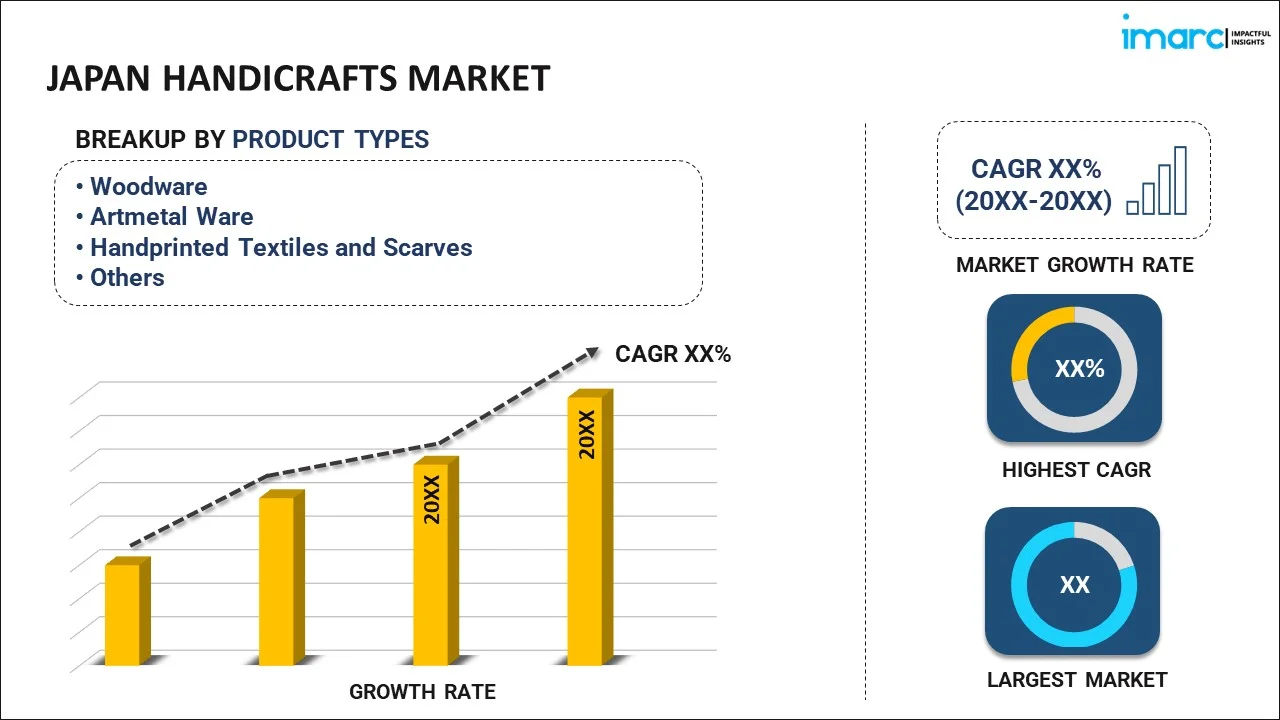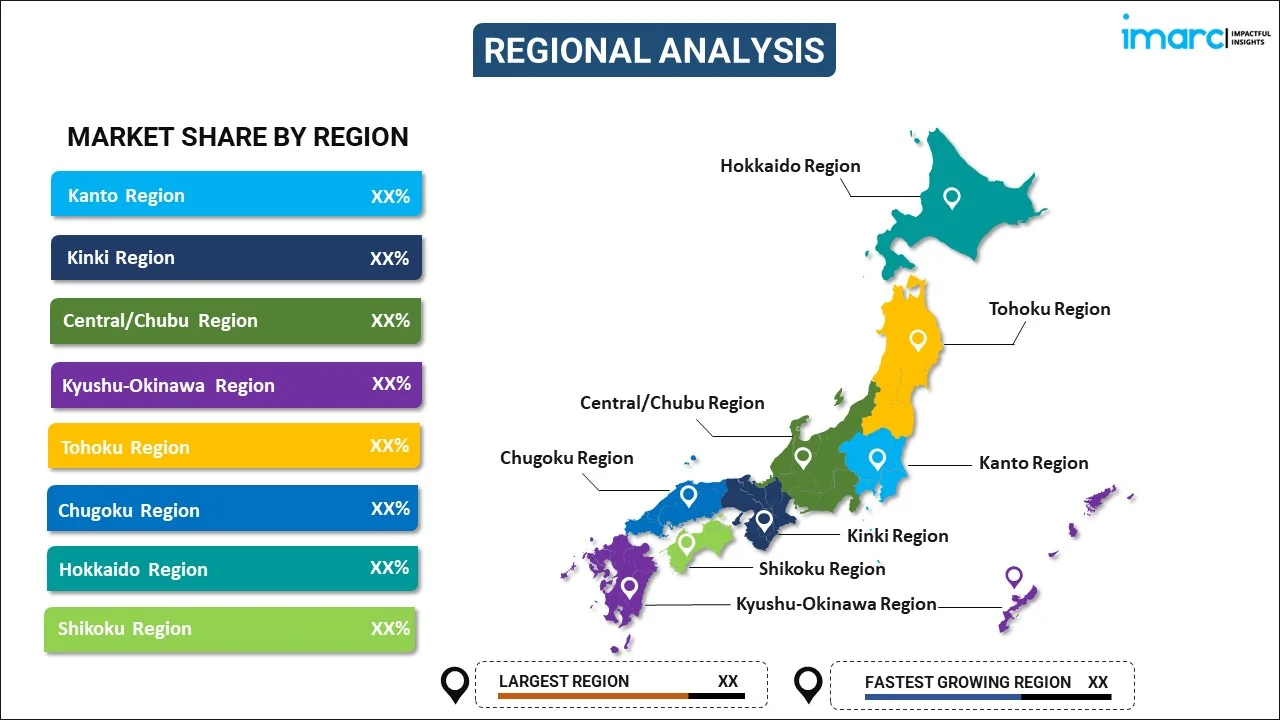
Japan Handicrafts Market Report by Product Type (Woodware, Artmetal Ware, Handprinted Textiles and Scarves, Embroidered and Crocheted Goods, Zari and Zari Goods, Imitation Jewelry, Sculptures, Pottery and Glass Wares, Attars and Agarbattis, and Others), Distribution Channel (Mass Retailers, Departmental Stores, Independent Retailers, Specialty Stores, Online Stores, and Others), End Use (Residential, Commercial), and Region 2025-2033
Market Overview:
The Japan handicrafts market size is projected to exhibit a growth rate (CAGR) of 10.17% during 2025-2033. The growing inclination toward cultural heritage and tradition, the growing preference for Japanese handicraft products among tourists, easy product availability across online marketplaces and e-commerce platforms and the introduction of customized designs represent some of the key factors driving the market.
|
Report Attribute
|
Key Statistics
|
|---|---|
|
Base Year
|
2024
|
|
Forecast Years
|
2025-2033
|
|
Historical Years
|
2019-2024
|
| Market Growth Rate 2025-2033 | 10.17% |
Handicraft refers to handmade products created using traditional skills and techniques, often emphasizing artistic or decorative qualities. They are typically created by skilled artisans and reflect the cultural heritage and craftsmanship of a particular region or community. They are often valued for their unique and authentic qualities, as well as their aesthetic appeal. Sculptures, pottery, woodware, scarves, toys, imitation jewelry, crocheted goods, furniture, and glassware are commonly available handicraft products. They are generally manufactured using materials, such as sheet metals, wood, natural fibers, papers, textiles, wrought iron, ceramics, beads, horns, bones, and river stones. Handicrafts are widely used for gift-giving, or decoration, such as paintings or sculptures. They are often sold as souvenirs, gifts, or collectibles and can be found in local markets, craft fairs, and online platforms.
Japan Handicrafts Market Trends:
The growing inclination toward cultural heritage and tradition is one of the key factors contributing to the market growth. Moreover, the appreciation for cultural heritage and the desire to preserve and promote traditional crafts is facilitating the demand for authentic Japanese handicrafts. In line with this, the widespread product utilization as a decoration material in households, offices, hotels, restaurants, and other commercial spaces, due to their high quality and unique design, is acting as another growth-inducing factor. Additionally, the increasing efforts by artisan communities, local governments, and organizations to promote traditional crafts and collaborate with contemporary designers are positively influencing the market growth. Besides this, the rising demand for sustainable handicrafts that are recyclable, safe, and manufactured using eco-friendly raw materials, such as recycled products, organic waste, grass, and vegetable dyes, is providing a considerable boost to the market growth. Furthermore, the growing preference for Japanese handicraft products among tourists, including souvenirs, symbolic imageries, religious objects, and decorative items for gifting purposes, is creating a positive outlook for the market. Apart from this, the easy product availability across online marketplaces and e-commerce platforms is propelling the market growth. Other factors, including the implementation of favorable government initiatives, rising expenditure capacities of consumers, the introduction of customized designs, and increasing demand for authentic and culturally significant handicrafts, are supporting the market growth.
Japan Handicrafts Market Segmentation:
IMARC Group provides an analysis of the key trends in each segment of the Japan handicrafts market report, along with forecasts at the country level for 2025-2033. Our report has categorized the market based on product type, distribution channel, and end use.
Product Type Insights:

- Woodware
- Artmetal Ware
- Handprinted Textiles and Scarves
- Embroidered and Crocheted Goods
- Zari and Zari Goods
- Imitation Jewelry
- Sculptures
- Pottery and Glass Wares
- Attars and Agarbattis
- Others
The report has provided a detailed breakup and analysis of the market based on the product type. This includes woodware, artmetal ware, handprinted textiles and scarves, embroidered and crocheted goods, Zari and Zari goods, imitation jewelry, sculptures, pottery and glass wares, attars and agarbattis, and others.
Distribution Channel Insights:
- Mass Retailers
- Departmental Stores
- Independent Retailers
- Specialty Stores
- Online Stores
- Others
A detailed breakup and analysis of the market based on the distribution channel has also been provided in the report. This includes mass retailers, departmental stores, independent retailers, specialty stores, online stores, and others.
End Use Insights:
- Residential
- Commercial
A detailed breakup and analysis of the market based on the end use has also been provided in the report. This includes residential and commercial.
Regional Insights:

- Kanto Region
- Kinki Region
- Central/Chubu Region
- Kyushu-Okinawa Region
- Tohoku Region
- Chugoku Region
- Hokkaido Region
- Shikoku Region
The report has also provided a comprehensive analysis of all the major regional markets, which include Kanto Region, Kinki Region, Central/Chubu Region, Kyushu-Okinawa Region, Tohoku Region, Chugoku Region, Hokkaido Region, and Shikoku Region.
Competitive Landscape:
The report has also provided a comprehensive analysis of the competitive landscape in the market. Competitive analysis such as market structure, key player positioning, top winning strategies, competitive dashboard, and company evaluation quadrant has been covered in the report. Also, detailed profiles of all major companies have been provided.
Japan Handicrafts Market Report Coverage:
| Report Features | Details |
|---|---|
| Base Year of the Analysis | 2024 |
| Historical Period | 2019-2024 |
| Forecast Period | 2025-2033 |
| Units | Billion USD |
| Scope of the Report | Exploration of Historical and Forecast Trends, Industry Catalysts and Challenges, Segment-Wise Historical and Predictive Market Assessment:
|
| Product Types Covered | Woodware, Artmetal Ware, Handprinted Textiles and Scarves, Embroidered and Crocheted Goods, Zari and Zari Goods, Imitation Jewelry, Sculptures, Pottery and Glass Wares, Attars and Agarbattis, Others |
| Distribution Channels Covered | Mass Retailers, Departmental Stores, Independent Retailers, Specialty Stores, Online Stores, Others |
| End Uses Covered | Residential, Commercial |
| Regions Covered | Kanto Region, Kinki Region, Central/Chubu Region, Kyushu-Okinawa Region, Tohoku Region, Chugoku Region, Hokkaido Region, Shikoku Region |
| Customization Scope | 10% Free Customization |
| Post-Sale Analyst Support | 10-12 Weeks |
| Delivery Format | PDF and Excel through Email (We can also provide the editable version of the report in PPT/Word format on special request) |
Key Questions Answered in This Report:
- How has the Japan handicrafts market performed so far and how will it perform in the coming years?
- What has been the impact of COVID-19 on the Japan handicrafts market?
- What is the breakup of the Japan handicrafts market on the basis of product type?
- What is the breakup of the Japan handicrafts market on the basis of distribution channel?
- What is the breakup of the Japan handicrafts market on the basis of end use?
- What are the various stages in the value chain of the Japan handicrafts market?
- What are the key driving factors and challenges in the Japan handicrafts market?
- What is the structure of the Japan handicrafts market and who are the key players?
- What is the degree of competition in the Japan handicrafts market?
Key Benefits for Stakeholders:
- IMARC’s report offers a comprehensive quantitative analysis of various market segments, historical and current market trends, market forecasts, and dynamics of the Japan handicrafts market from 2019-2033.
- The research study provides the latest information on the market drivers, challenges, and opportunities in the Japan handicrafts market.
- Porter's five forces analysis assist stakeholders in assessing the impact of new entrants, competitive rivalry, supplier power, buyer power, and the threat of substitution. It helps stakeholders to analyze the level of competition within the Japan handicrafts industry and its attractiveness.
- Competitive landscape allows stakeholders to understand their competitive environment and provides an insight into the current positions of key players in the market.
Need more help?
- Speak to our experienced analysts for insights on the current market scenarios.
- Include additional segments and countries to customize the report as per your requirement.
- Gain an unparalleled competitive advantage in your domain by understanding how to utilize the report and positively impacting your operations and revenue.
- For further assistance, please connect with our analysts.
 Inquire Before Buying
Inquire Before Buying
 Speak to an Analyst
Speak to an Analyst
 Request Brochure
Request Brochure
 Request Customization
Request Customization




.webp)




.webp)












